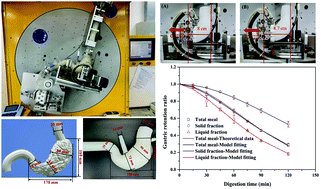Achieving realistic gastric emptying curve in an advanced dynamic in vitro human digestion system: experiences with cheese—a difficult to empty material†
Abstract
Nowadays, in vitro digestion models have received growing interest in recent years to track the digestive fate of foods in the gastrointestinal tract. A major challenge in the development of more physiologically relevant in vitro gastric models is to simulate realistic gastric emptying. In this study, an advanced dynamic in vitro human gastric system was investigated for its potential in achieving the above. The mechanisms for controlling the gastric emptying rate by modulations of the peristaltic moving distance, the pylorus opening size/frequency, and the stomach tilting angle in relation to time are illustrated. With solid cheese, a difficult food material for emptying, different combinations of the operational parameters of the stomach system were evaluated. The system was steered to attain consistent gastric emptying curve with the theoretical data by optimizing operational parameters. By fitting the gastric retention data with a power-exponential model, which is a common approach for describing gastric emptying, the total meal achieved an average emptying half-time (t1/2) of 84.5 min and a curve shape coefficient (β) of 1.69, similar to the theoretical data reported in the literature, where the values of t1/2 and β were 85 min and 1.8, respectively (p > 0.05). Furthermore, the mean median particle size was significantly decreased from the initial 2.80 mm (cheese cubes) to the final 1.35 mm (p < 0.05). There are few particles greater than 2 mm observed in the emptied cheese digesta throughout the digestion process. These suggest the powerful gastric grinding and sieving capacity exhibited by the in vitro system. The current study demonstrates that a well-considered in vitro system can offer a reasonable approach for tracking the structural and physicochemical changes of foods during digestion in the stomach, which is practically meaningful.



 Please wait while we load your content...
Please wait while we load your content...